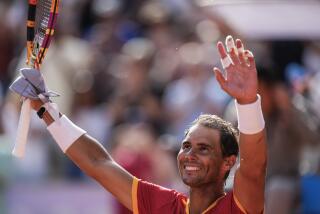Federer Is Through Looking Glass
- Share via
PARIS — Does Roger Federer solve the puzzle known as Rafael Nadal in Sunday’s French Open final by taking a page out of the playbook of Paul-Henri Mathieu, who ran Rafa ragged here in the third round for almost five hours before losing?
Or does he follow the blueprint for what Ivan Ljubicic tried to do in Friday’s semifinal: serve big and approach up the middle, often taking away those angles so openly coveted by Nadal?
Then there’s this outrageous theory for the most eagerly awaited men’s French Open final in more than two decades: Let Federer Be Federer.
“I like to think he’s the Rubik’s Cube -- when things aren’t going so well, he turns it to one side, or he turns it to the other side and he finds the answer,” said ESPN’s Brad Gilbert, the former coach of Andre Agassi and Andy Roddick.
“So even if he went down two sets to none, I would have been thinking, ‘When is he going to turn the cube, turn the small trick?’ ”
Gilbert was referring to Federer’s semifinal against David Nalbandian of Argentina. Federer won the shortened match Friday, 3-6, 6-4, 5-2, when Nalbandian retired because of a strained abdominal muscle, apparently aggravating an injury suffered in the previous round. Defending champion Nadal joined Federer in the final by beating Ljubicic, 6-4, 6-2, 7-6 (7), extending his clay-court winning streak to 59 matches.
Federer’s cube-turning moment came in the seventh game of the second set when he sprinted back to the baseline to retrieve a lob, and whipped a forehand passing shot down the line.
That’s the simple description.
Federer gave credit to his years of playing squash with his father. One Spanish reporter said the sweeping shot looked like the flourish of a bullfighter swinging a cape.
“I can’t pull off those shots on a consistent basis,” Federer said. “They give you a little bit of tailwind.”
The shot came during a stretch in which Federer won five straight games and eight of 10. He had started slowly, losing the first set and trailing, 0-3, in the second.
“If he’d been leading 5-0 in the third set, he wouldn’t have given up,” he said of Nalbandian.
This will be the first French Open men’s singles final featuring the top two seeded players since Ivan Lendl defeated John McEnroe in 1984 in five sets, and only the third since the open era began in 1968.
Federer said he did not think a shortened semifinal would give him an extra edge against Nadal. Though Nadal’s matches have been longer for the most part, he got a break as well when his quarterfinal opponent, Novak Djokovic, retired because of an injury after two sets.
Nadal’s only real crisis point in Friday’s semifinal came in the third-set tiebreaker when he trailed, 3-5, and had received an earlier warning from the chair umpire for taking too much time between points. After the match, Ljubicic criticized Nadal for the same issue that brought the warning, and added that he thought “everybody” would like to see Federer win Sunday.
It’s not often that No. 1 Federer comes into a final not favored. But Nadal has defeated him in five of their six meetings and has won all three of their matches on clay. Two of those were this spring, the finals in Monte Carlo and Rome.
At the Italian Open in Rome, Federer squandered a 4-1 fifth-set lead and two match points.
“He has been getting closer,” said TV commentator Mary Carillo. “He’s been talking about the French Open since the Australian. I think, a year on, people play against Nadal better. They’re used to his spin, they’re used to his game. Ljubicic, he knew what had to happen. He couldn’t make it happen.”
Having won the Australian Open in January, Federer would be halfway to a calendar Grand Slam should he defeat Nadal in Sunday’s final. The last male player to complete the Slam -- winning the Australian Open, the French Open, Wimbledon and the U.S. Open in the same year -- was Rod Laver in 1969.
A victory Sunday would also be Federer’s fourth straight Slam title.
Old-school references to the likes of Laver are probably lost on the 20-year-old Nadal, as is reporters’ comparing Nadal-Federer to Muhammad Ali-Joe Frazier. “Maybe I wasn’t born, no?” Nadal said.
Gilbert supplied a better reference point for Nadal’s generation, speaking about the last great rivalry in men’s tennis, Pete Sampras versus Agassi, and tossing in an older legend, Bjorn Borg.
“You’ve got Nadal, swashbuckling Nike-like Agassi, and Federer is kind of like Sampras,” Gilbert said. “The reason it is so epic and special is that one guy is on the verge of chasing history and one guy might be the best clay-court player since Borg. So to make history, he has to go through the new Borg.”
More to Read
Go beyond the scoreboard
Get the latest on L.A.'s teams in the daily Sports Report newsletter.
You may occasionally receive promotional content from the Los Angeles Times.











